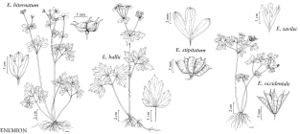Difference between revisions of "Enemion occidentale"
Bull. Misc. Inform. Kew 1920: 160. 1920.
Common names: Western rue-anemone
EndemicIllustrated
Basionym: Isopyrum occidentale Hooker & Arnott Bot. Beechey Voy., 316. 1841
Treatment appears in FNA Volume 3.
FNA>Volume Importer |
imported>Volume Importer |
||
| (7 intermediate revisions by 2 users not shown) | |||
| Line 13: | Line 13: | ||
}}{{Treatment/ID/Special_status | }}{{Treatment/ID/Special_status | ||
|code=F | |code=F | ||
| − | |label= | + | |label=Illustrated |
}} | }} | ||
| − | |basionyms={{Treatment/ID/ | + | |basionyms={{Treatment/ID/Basionym |
|name=Isopyrum occidentale | |name=Isopyrum occidentale | ||
|authority=Hooker & Arnott | |authority=Hooker & Arnott | ||
| + | |rank=species | ||
| + | |publication_title=Bot. Beechey Voy., | ||
| + | |publication_place=316. 1841 | ||
}} | }} | ||
|synonyms= | |synonyms= | ||
| Line 27: | Line 30: | ||
}}<!-- | }}<!-- | ||
| − | --><span class="statement" id="st- | + | --><span class="statement" id="st-undefined" data-properties=""><b>Stems </b>10-40 cm, cespitose, not rhizomatous; roots tuberous. <b>Leaves</b> abaxially glabrous; leaflets irregularly 2-3-lobed, lobes often with 1-3 secondary lobes; apex rounded, glandular-apiculate. <b>Inflorescences</b> axillary, flowers solitary or loosely grouped in 2-3-flowered leafy cymes; peduncle not strongly clavate. <b>Flowers</b>: sepals (5-)7-11.5 × 2.8-7 mm; stamens 20-40; filaments filiform to club-shaped, 2.2-6 mm. <b>Follicles</b> sessile, upright to widely divergent; body oblong, (7.7-)8.5-11.5 mm, abruptly contracted into style beak; beak 0.8-1.7 mm. <b>Seeds</b> 1.5-2 mm, glabrous.</span><!-- |
-->{{Treatment/Body | -->{{Treatment/Body | ||
| Line 34: | Line 37: | ||
|elevation=200-1500 m | |elevation=200-1500 m | ||
|distribution=Calif. | |distribution=Calif. | ||
| − | |discussion=<p>Enemion occidentale is endemic to California where it is infrequent and local (P. A. Munz 1959).</p> | + | |discussion=<p><i>Enemion occidentale</i> is endemic to California where it is infrequent and local (P. A. Munz 1959).</p> |
|tables= | |tables= | ||
|references= | |references= | ||
| Line 43: | Line 46: | ||
-->{{#Taxon: | -->{{#Taxon: | ||
name=Enemion occidentale | name=Enemion occidentale | ||
| − | |||
|authority=(Hooker & Arnott) J. R. Drummond & Hutchinson | |authority=(Hooker & Arnott) J. R. Drummond & Hutchinson | ||
|rank=species | |rank=species | ||
| Line 57: | Line 59: | ||
|publication title=Bull. Misc. Inform. Kew | |publication title=Bull. Misc. Inform. Kew | ||
|publication year=1920 | |publication year=1920 | ||
| − | |special status=Endemic; | + | |special status=Endemic;Illustrated |
| − | |source xml=https:// | + | |source xml=https://bitbucket.org/aafc-mbb/fna-data-curation/src/2e0870ddd59836b60bcf96646a41e87ea5a5943a/coarse_grained_fna_xml/V3/V3_294.xml |
|genus=Enemion | |genus=Enemion | ||
|species=Enemion occidentale | |species=Enemion occidentale | ||
| − | |||
| − | |||
| − | |||
| − | |||
| − | |||
| − | |||
| − | |||
| − | |||
| − | |||
| − | |||
| − | |||
| − | |||
| − | |||
| − | |||
| − | |||
| − | |||
| − | |||
| − | |||
| − | |||
| − | |||
| − | |||
| − | |||
| − | |||
| − | |||
| − | |||
| − | |||
| − | |||
| − | |||
| − | |||
}}<!-- | }}<!-- | ||
-->[[Category:Treatment]][[Category:Enemion]] | -->[[Category:Treatment]][[Category:Enemion]] | ||
Latest revision as of 22:47, 5 November 2020
Stems 10-40 cm, cespitose, not rhizomatous; roots tuberous. Leaves abaxially glabrous; leaflets irregularly 2-3-lobed, lobes often with 1-3 secondary lobes; apex rounded, glandular-apiculate. Inflorescences axillary, flowers solitary or loosely grouped in 2-3-flowered leafy cymes; peduncle not strongly clavate. Flowers: sepals (5-)7-11.5 × 2.8-7 mm; stamens 20-40; filaments filiform to club-shaped, 2.2-6 mm. Follicles sessile, upright to widely divergent; body oblong, (7.7-)8.5-11.5 mm, abruptly contracted into style beak; beak 0.8-1.7 mm. Seeds 1.5-2 mm, glabrous.
Phenology: Flowering early spring.
Habitat: Shaded places, oak woodland, chaparral, and coniferous and deciduous woods
Elevation: 200-1500 m
Discussion
Enemion occidentale is endemic to California where it is infrequent and local (P. A. Munz 1959).
Selected References
None.
Lower Taxa
None.

